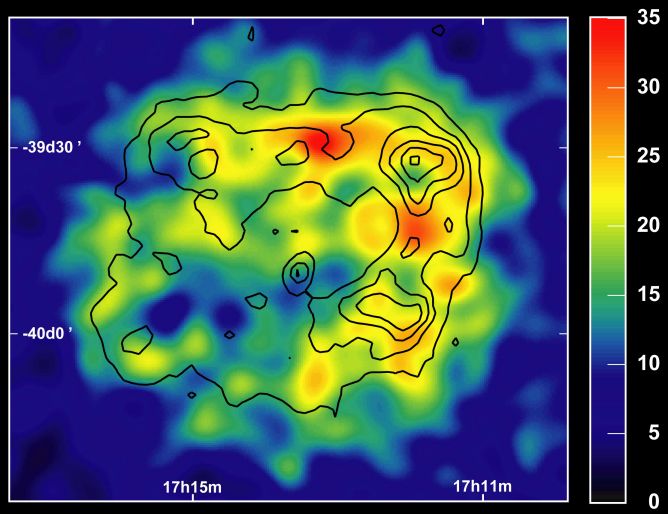Credit: HESS Collaboration -
image courtesy Werner Hofmann
(MPI)
Explanation:
Gamma rays are the most energetic
form of light.
With up to a billion times the energy of ordinary "medical"
x-rays,
they easily penetrate telescope lenses and mirrors, making it
very difficult to create
gamma-ray images of cosmic sources.
Still, an array of large telescopes
designed to detect gamma-ray
induced atmospheric flashes - the HESS
(High Energy
Stereoscopic System)
experiment - has produced this historic, resolved image of a
supernova remnant at extreme
gamma-ray energies.
Astronomers note that the
premier
gamma-ray view of the expanding
stellar debris cloud is clearly similar to x-ray images of the remnant
and convincingly supports the idea that these sites of powerful
shock waves are also sources of cosmic
rays within our galaxy.
The gamma-ray intensity is color-coded in the picture, shown with
dark contour lines that trace levels of x-ray emission
from the object.
At an estimated distance of 3,000 light-years, the supernova
remnant measures about 50 light-years across and
lies near the galactic plane.
1999 2000 2001 2002 2003 2004 2005 2006 2007 |
Январь Февраль Март Апрель Май Июнь Июль Август Сентябрь Октябрь Ноябрь Декабрь |
NASA Web Site Statements, Warnings, and Disclaimers
NASA Official: Jay Norris. Specific rights apply.
A service of: LHEA at NASA / GSFC
& Michigan Tech. U.
|
Публикации с ключевыми словами:
supernova remnant - остаток Сверхновой - gamma ray - гамма-излучение
Публикации со словами: supernova remnant - остаток Сверхновой - gamma ray - гамма-излучение | |
См. также:
Все публикации на ту же тему >> | |
